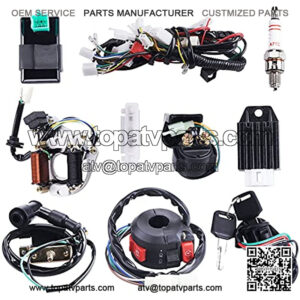The spark plug wire has one crucial job: to deliver the high voltage from the ignition coil or distributor to the spark plug.
When spark plug wire resistance is too high, the spark plug won’t receive enough voltage to create a strong spark, which can then cascade into a series of engine performance issues.
So, what exactly is spark plug wire resistance?
And how do you measure it?
We’ll tackle both these questions in the following paragraphs. We’ll also explore what plug wire diameter has to do with resistance, and cover some related FAQs.
What Is Spark Plug Wire Resistance?
Spark energy travels from the ignition coil or distributor through the spark plug wire to get to the spark plug, which is why the plug wire is also called an ignition wire or coil wire.
Now, imagine the plug wire is a water hose, and the spark is the water running through it. Resistance would be like sand in the hose, impeding the water’s flow.
Lower resistance means more spark energy from the coil reaches the spark plug to ignite the air-fuel mixture in the cylinder. And the converse applies with higher resistance.
The distance traveled also matters. So, spark plug wire resistance is measured in ohms per foot. A high resistance wire can measure around 5,000 ohms per foot, while a low resistance wire can easily fall in the 2-digit ohm per foot range.
Here are some generic examples of plug wire resistance per foot:
- Copper core wire: 1-6,500 ohms
- Inductive wire: 650-2,500 ohms
- Carbon core wire: 3,000-7,000 ohms
The factory wire (OEM wires) for domestic vehicles are typically fiberglass core spark wires with 10,000-12,000 ohms (10-12 k ohm) of resistance per foot. Meanwhile, import models may utilize a spiral wound wire with 500 ohms per foot of resistance.
The general rule is that the largest spark plug wire shouldn’t have more than 50,000 ohms of total resistance for resistive wires like those with a fiberglass core.
In late-model cars, coil-on-plug systems eliminate the need for spark plug wires, further reducing resistance and voltage loss between the ignition coil and spark plug.
Now, let’s measure the wire resistance.
How To Test Spark Plug Wire Resistance
Measuring the spark plug wire resistance is pretty straightforward. You’ll need an ohm meter or digital multimeter (set to measure ohms).
With the engine off, here’s how:
- Detach the sparkplug wire at each end — from the spark plug connector and ignition coil (or distributor) connector.
- Check your owner’s manual for your plug wire resistance range — it’ll be in kiloohm (k ohm). Multiply the wire length in ohms per foot (if your wire is 2 feet long and the manual requires 15-19k ohms per foot, you’d want a measurement of 30-38k ohms).
- Set the ohm meter to the nearest setting larger than the required resistance range (e.g., for a 15-19k ohm range, set the dial to “20k”).
- Touch the ohm meter leads to a metal center at each connector end of the spark plug wire, and note down the reading.
- Compare the ohm meter reading to your required specification.
Higher readings mean too much resistance in the ignition wire, and you should probably get a new wire. Even if the spark wire meets specifications, you should still check it for physical damage and voltage leaks.
So, let’s say you need a new wire.
Should you get the same diameter wire as the OEM wires?
Does Diameter Affect Spark Plug Wire Resistance?
Modern spark plug wires usually have different layers of insulation. Generally, an increase in insulator thickness means an increase in coil wire resistance.
The difference between a 7mm, 8mm, or 10mm plug wire (for example) is usually in the outer silicone jacket or inner silicone insulation. The core remains the same, regardless of overall wire diameter.
Why is this so?
A larger outer diameter increases protection for the conductive core. This helps insulate it from arcing, and suppresses electromagnetic interference (EMI) and radio frequency interference (RFI).
Late-model vehicles often have tons of electronic devices that can be affected by a poorly insulated sparkplug wire. So, a wire with high levels of EMI and RF noise suppression is desirable — like a spiral core wire, for instance.
However, increased EMI and RF noise suppression often means increased cost and wire resistance as well.
Ultimately, the choice of spark plug wires is driven by vehicle application.
A racer with minimal electronics might use a low resistance, solid core wire that’ll provide lots of spark power. A solid wire, like the copper core wire, often has little EMI/RFI suppression. In contrast, a passenger vehicle is likely fine sticking to its stock wire despite having more resistance than an aftermarket wire set.
That said, there are resistor spark plug wires on the market designed to suppress radio frequency interference, but still have a lower resistance than the conventional carbon core wire.
Now that we’ve gotten the basics of spark plug wire resistance down, let’s look at some FAQs.
3 Spark Plug Wire FAQs
Here are the answers to some spark plug wire questions:
1. What Are Signs Of Spark Plug Wire Failure?
Spark plug wires will wear out over time, whether it’s a spiral core wire, solid core wire, or otherwise. Internal conductors may break or burn, and the insulation can deteriorate, allowing high voltage to leak.
Failing spark plug wires cause several vehicle issues, like:
- Engine misfire
- Rough idling
- Poor engine performance
- Incomplete combustion
- Poor fuel economy
Bear in mind that bad spark plug wires share similar symptoms to other failing engine components, like the ignition coil or spark plug itself. So, it’s advisable to have a professional mechanic take a look.
2. When Should I Replace My Spark Plug Wires?
Physical damage to the spark wires would be your cue to get a replacement wire set.
A visual inspection can reveal damage — like cracks, cuts, or burns on the wire. Also, check the connector boots at each end of the wire, and the terminals for corrosion or a loose fit.
3. How Do I Test Spark Plug Wires For A Spark?
For this, you’ll need a spark tester.
Here’s what to do:
- Detach the spark plug wire from the spark plug.
- Attach the spark tester to the wire and any engine ground.
- Crank the engine and check the spark produced at the spark tester gap. A strong spark will be blue-white and clearly visible in daylight. A weak spark will be reddish or orange and harder to see in daylight.
If there’s no spark, you may want to repeat the process but test at the distributor cap, as the issue might not be the spark plug wire at all.
About Spark Plug Wire
“single spark plug wire”
“spark plug wire set”
“spark plug wire crimper”
“spark plug wire ends”
“spark plug wires price”
“bulk spark plug wire”

